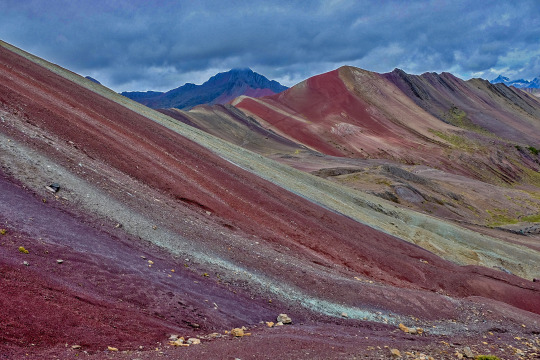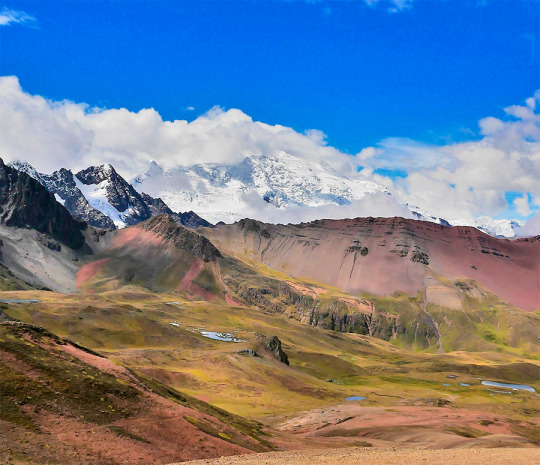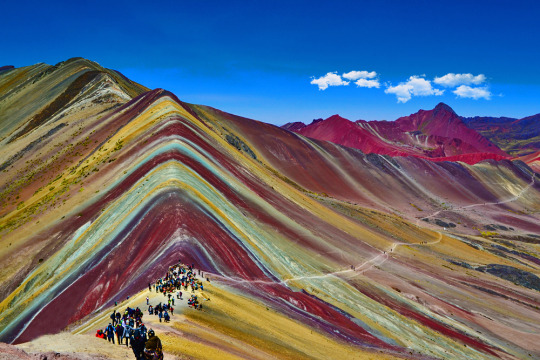
Useful Information
- Starting Altitude - 3800m / 12,467ft..
- Highest Altitude - 5000m / 16.404ft.
- Meals - 2 breakfast, 2 lunch, 1 dinner
- Overall Difficulty - Moderate
- STARTING POINT: - Cusco at your hotel
RAINBOW MOUNTAIN ITINERARY
DAY 1: CUSCO – OCONGATE – UPIS
This first day we’ll leave Cusco very early for our three-hour trip in a private vehicle to the small village of Tinqui (3,800 meters). We will go by beautiful landscapes and several traditional villages as Urcos, Cattca and Ocangate. In Tinqui we will have lunch, after lunch we begin to walk through beautiful mountain landscapes with great views of Mount Ausangate. We walk for an average of 4 hours to reach the hot springs in Upis (4400 meters). In this place we will have dinner and spend the night.
DAY 2: UPIS – PUCA COCHA
After breakfast, we head to the first pass called the Abra Arapa (4850 meters). After passing the Abra we will have lunch, After lunch we continue on to Lake Pucacocha- a blue lake and a perfect stop for a break. Along the way you will see local herders and llamas, Ausangate mountain to your left, and you will have your expert guide explaining the history of the locals and talking about the landscape along the way. If you're lucky you may see condors and vicuñas at our campsite where you will be surrounded by high mountains and incredible glaciers- watch for the Ausangate glacier crashing into the lake below! As always camp will be set up for you to change and rest your weary legs and dinner will be prepared.
DAY 3: PUCA COCHA — ANANTA
After breakfast, We will start with a steep ascent of Puca Cocha pass. While is partially difficult, this pass boasts incredible views the entire way. The higher you get the more impressive the lake is below and Ausangate mountain sitting directly across from we. Take some time to enjoy these beautiful views. We will have plenty of time to take wonderful and impressive photographs. After conquering the pass we continue through a vivid green valley with llamas grazing everywhere. As you approach our destination for the day we will have camp set up for you to enjoy your surroundings and relax.
DAY 4: ANANTA — RAINBOW MOUNTAIN — Q´ESIUNO — CUSCO

We will wake you up extra early in the morning so you will can be the first people to the top of the Rainbow Mountain. After a hot breakfast, and some coca tea we will start with the first uphill climb- Ananta pass. Here you will see the beautiful Rainbow Mountain in the distance. From here you descend to a large valley and continue walking until we are presented with one final climb to the Vinicunca Mountain. We are going be the first ones at the Rainbow Mountain to enjoy the place at all with plenty of time for photographing, walk around and enjoy the beauty of the area. After we hike downhill for 2.5 hours to Qesoyuno where you have a delicious lunch surrounded by mountains. After lunch the car from the company will pick up us to drive back to cusco for 3.5 hours to take you back to your hotel.
WHAT TO BRING
- A backpack
- A beanie hat or ear warmer
- Sun hat
- Scarf
- Gloves
- A mid weight sweater
- A longsleeve t-shirt
- 1 – 2 t-shirts
- A lightweight suater or vest
- A pair of long pants
- Hiking shoes
- An extra pair of shoe
- 2 – 3 pairs wool socks
- A jacket
- A small towel
- Rain gear
- 1 – 2 pair shorts
- Sunglasses
- A small headlamp
- Waterbottle
- A toothbrust and other personal toiletries
- Toilet paiper
- Sun cream
- Camera and film
- Original passport (International Student Identity Card “ISIC” if applicable)
- Extra money for drinks.
- Emergency money at least 300-450 extra soles (USD$ 220)




















